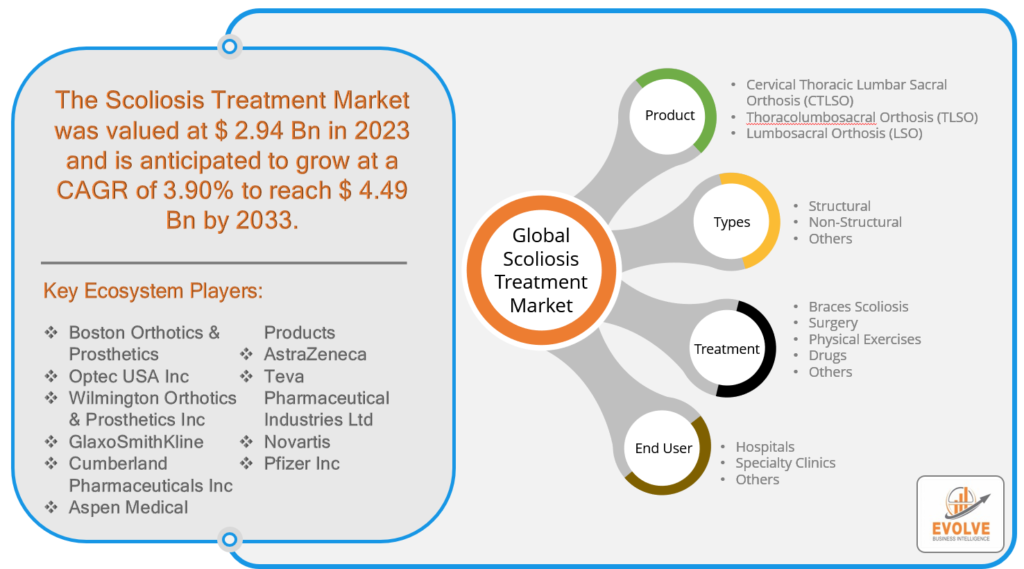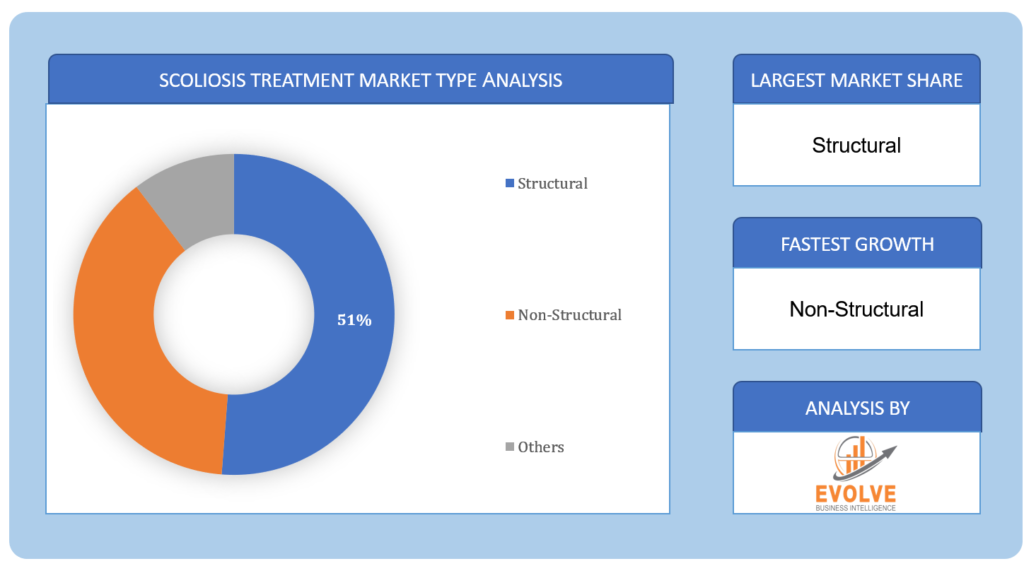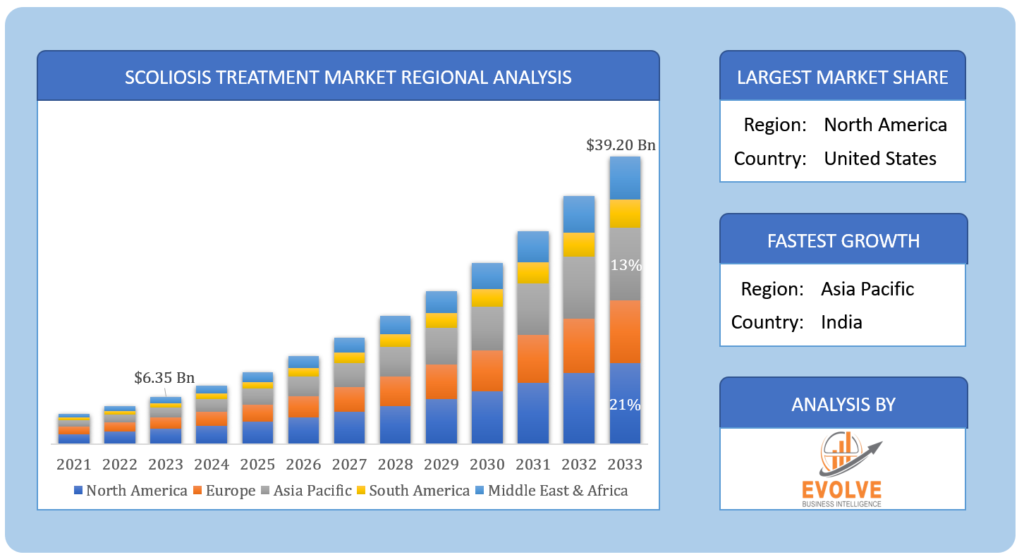Scoliosis Treatment Market Overview
Scoliosis Treatment Market Size is expected to reach USD 4.49 Billion by 2033. The Scoliosis Treatment industry size accounted for USD 2.94 billion in 2023 and is expected to expand at a compound annual growth rate (CAGR) of 3.90% from 2023 to 2033. “Scoliosis Treatment” refers to the global or regional market that encompasses the various products, services, and interventions used for the treatment of scoliosis. This market includes a wide range of medical devices, therapies, medications, and surgical procedures that are used to address the curvature of the spine in individuals with scoliosis. The scoliosis treatment market is influenced by factors such as the prevalence of scoliosis, advancements in medical technology, availability of healthcare infrastructure, reimbursement policies, and patient demographics. The market may be driven by demand from patients with scoliosis, healthcare providers, hospitals, and other stakeholders involved in the management and treatment of scoliosis. Companies and manufacturers that develop and market products and services for scoliosis treatment, as well as healthcare providers and facilities that offer scoliosis treatment services, are part of the scoliosis treatment market.
the impact of COVID-19 on the scoliosis treatment market may vary by region, depending on the severity and duration of the pandemic, local healthcare system capacity, and government policies. It’s recommended to consult up-to-date market research and seek advice from healthcare professionals for the latest information on the scoliosis treatment market in the context of COVID-19.
Market Dynamics
The major factors that have impacted the growth of Scoliosis Treatment are as follows:
Drivers:
- Growing demand for minimally invasive procedures
Minimally invasive surgical techniques, such as thoracoscopic and laparoscopic approaches, have gained popularity in scoliosis treatment due to their potential benefits, such as shorter hospital stays, faster recovery, and reduced complications. The growing demand for minimally invasive procedures is driving the adoption of these techniques in scoliosis treatment, contributing to the growth of the market.
Restraint:
- Risks and complications associated with treatment
Scoliosis treatment, particularly surgical interventions, may carry risks and complications, such as infection, nerve damage, or implant failure. These risks may pose concerns for patients and may impact their decision-making regarding treatment options, potentially leading to delays or hesitations in seeking treatment.
Opportunity:
- Technological advancements in surgical interventions
Advancements in surgical techniques, such as minimally invasive procedures, computer-assisted surgery, and robotic-assisted surgery, have the potential to improve surgical outcomes, reduce complications, and shorten recovery times. These technological advancements present opportunities for the development of advanced surgical tools, implants, and techniques in scoliosis treatment.
Scoliosis Treatment Market Segment Overview
Based on the Product, the Scoliosis Treatment market is segmented based on Cervical Thoracic Lumbar Sacral Orthosis (CTLSO), Thoracolumbosacral Orthosis (TLSO), and Lumbosacral Orthosis (LSO). The Cervical Thoracic Lumbar Sacral Orthosis (CTLSO) segment is expected to hold the largest market share, CTLSO is a type of brace that is commonly used in the treatment of scoliosis, providing support and correction to the cervical, thoracic, lumbar, and sacral spine regions. CTLSO braces are typically prescribed for moderate to severe cases of scoliosis and are often used in conjunction with other treatment modalities.
By Types
Based on Types, the global Scoliosis Treatment market has been divided into Structural, Non-Structural, and Others. The Structural segment is expected to hold the largest market share. The Structural segment, which includes treatment options such as braces, spinal fusion surgery, and vertebral body tethering, was expected to hold the largest market share in the Scoliosis Treatment market. This is because these treatment options are commonly used for managing moderate to severe scoliosis cases, where structural intervention is required to correct the spinal curvature.
By Treatment
Based on Treatment, the global Scoliosis Treatment market has been divided into Braces Scoliosis, Surgery, Physical Exercises, Drugs, and Others. The Braces Scoliosis segment is expected to hold the largest market share. Braces are commonly used as a non-surgical treatment option for managing scoliosis, particularly in cases of mild to moderate spinal curvature. There are different types of braces used for scoliosis treatment, such as Boston Brace, Charleston Bending Brace, Milwaukee Brace, and others. These braces are designed to provide external support to the spine, help correct the alignment of the spine, and prevent further progression of the spinal curvature, especially during the growth period in children and adolescents.
By End User
Based on End Users, the global Scoliosis Treatment market has been divided into Hospitals, Specialty Clinics, and Others. The Hospitals segment holds the largest market share of Scoliosis Treatment. Hospitals may also have access to specialized equipment and facilities, such as advanced imaging technologies, operating rooms, and rehabilitation services, which are crucial for the diagnosis and treatment of scoliosis. They may also have a team of healthcare professionals, including orthopedic surgeons, physical therapists, and other specialists, who work together to provide comprehensive care to patients with scoliosis.
Global Scoliosis Treatment Market Share, by Segmentation
 Scoliosis Treatment Market Regional Analysis
Scoliosis Treatment Market Regional Analysis
Based on region, the global Scoliosis Treatment market has been divided into North America, Europe, Asia-Pacific, and the Rest of the World. North America is projected to dominate the use of the Scoliosis Treatment market followed by the Asia-Pacific and Europe regions.
North America Market
North America is one of the dominant regions in the Scoliosis Treatment market, The prevalence of scoliosis, a medical condition characterized by abnormal curvature of the spine, is relatively high in North America, leading to significant demand for scoliosis treatment options. North America is known for its advanced healthcare infrastructure, well-established medical facilities, and high adoption of advanced medical technologies. These factors contribute to the development and availability of various treatment options for scoliosis, including surgical and non-surgical interventions. Additionally, North America has a large patient population and relatively higher healthcare spending compared to other regions, which further supports the growth of the scoliosis treatment market. There are also many research and development activities, clinical trials, and innovations in scoliosis treatment taking place in North America, driven by the presence of leading medical institutions and companies in the region.
Europe Market
Europe is indeed considered one of the major regions in the global scoliosis treatment market, and it holds a significant market share, often considered the second-largest after North America. Europe has a relatively high prevalence of scoliosis, which drives the demand for effective treatment options in the region. European countries are known for their well-established healthcare systems, advanced medical facilities, and a strong focus on research and development. Many countries in Europe have specialized scoliosis treatment centers, expert healthcare professionals, and advanced technologies for diagnosing and treating scoliosis. These factors contribute to the growth of the scoliosis treatment market in Europe. Furthermore, Europe has a favorable regulatory environment for medical devices, including those used in scoliosis treatment, with stringent safety and efficacy standards. This allows for the availability of a wide range of treatment options for scoliosis patients in the region, including conservative management approaches such as bracing, physiotherapy, and exercise, and surgical interventions like spinal fusion or vertebral body tethering.
Competitive Landscape
The market comprises tier-1, tier-2, and local players. With their wide product portfolios, tier-1 and tier-2 players have a global reach. Since of their strategic innovations and broad regional presence, companies such as Novartis, Pfizer Inc, GlaxoSmithKline, and Cumberland Pharmaceuticals Inc lead the global Scoliosis Treatment business. To increase their market position and attract a wide consumer base, the businesses are employing various strategies, such as growth, product releases, and alliances.
Prominent Players:
- Boston Orthotics & Prosthetics
- Optec USA Inc
- Wilmington Orthotics & Prosthetics Inc
- GlaxoSmithKline
- Cumberland Pharmaceuticals Inc
- Aspen Medical Products
- AstraZeneca
- Teva Pharmaceutical Industries Ltd
- Novartis
- Pfizer Inc
Key Development:
February 2022: Pfizer Inc. and OPKO Health, Inc. announced that the European Commission had approved the once-weekly injection of next-generation long-acting recombinant human growth hormone NGENLATM to treat children and adolescents from the age of 3 who have growth disturbances caused by insufficient growth hormone secretion.
Scope of the Report
Global Scoliosis Treatment Market, by Product
- Cervical Thoracic Lumbar Sacral Orthosis (CTLSO)
- Thoracolumbosacral Orthosis (TLSO)
- Lumbosacral Orthosis (LSO)
Global Scoliosis Treatment Market, by Types
- Structural
- Non-Structural
- Others
Global Scoliosis Treatment Market, by Treatment
- Braces Scoliosis
- Surgery
- Physical Exercises
- Drugs
- Others
Global Scoliosis Treatment Market, by End User
- Hospitals
- Specialty Clinics
- Others
Global Scoliosis Treatment Market, by Region
- North America
- US
- Canada
- Mexico
- Europe
- UK
- Germany
- France
- Italy
- Spain
- Benelux
- Nordic
- Rest of Europe
- Asia Pacific
- China
- Japan
- South Korea
- Indonesia
- Australia
- Malaysia
- India
- Rest of Asia Pacific
- South America
- Brazil
- Argentina
- Rest of South America
- Middle East & Africa
- Saudi Arabia
- UAE
- Egypt
- South Africa
- Rest of Middle East & Africa
| Parameters | Indicators |
|---|---|
| Market Size | 2033: $ 4.49 Billion |
| CAGR | 3.90% CAGR (2023-2033) |
| Base Year | 2022 |
| Forecast Period | 2023-2033 |
| Historical Data | 2021 |
| Report Coverage | Revenue Forecast, Competitive Landscape, Growth Factors, and Trends |
| Key Segmentations | Product, Types, Treatment, End User |
| Geographies Covered | North America, Europe, Asia-Pacific, Latin America, Middle East & Africa |
| Key Players | Boston Orthotics & Prosthetics, Optec USA Inc, Wilmington Orthotics & Prosthetics Inc, GlaxoSmithKline, Cumberland Pharmaceuticals Inc, Aspen Medical Products, AstraZeneca, Teva Pharmaceutical Industries Ltd, Novartis, Pfizer Inc |
| Key Market Opportunities | Technological advancements in surgical interventions |
| Key Market Drivers | Growing demand for minimally invasive procedures |
REPORT CONTENT BRIEF:
- High-level analysis of the current and future Scoliosis Treatment market trends and opportunities
- Detailed analysis of current market drivers, restraining factors, and opportunities in the future
- Scoliosis Treatment market historical market size for the year 2021, and forecast from 2023 to 2033
- Scoliosis Treatment market share analysis at each product level
- Competitor analysis with a detailed insight into its product segment, financial strength, and strategies adopted.
- Identifies key strategies adopted including product launches and developments, mergers and acquisitions, joint ventures, collaborations, and partnerships as well as funding taken and investment done, among others.
- To identify and understand the various factors involved in the global Scoliosis Treatment market affected by the pandemic
- To provide a detailed insight into the major companies operating in the market. The profiling will include the financial health of the company’s past 2-3 years with segmental and regional revenue breakup, product offering, recent developments, SWOT analysis, and key strategies.








